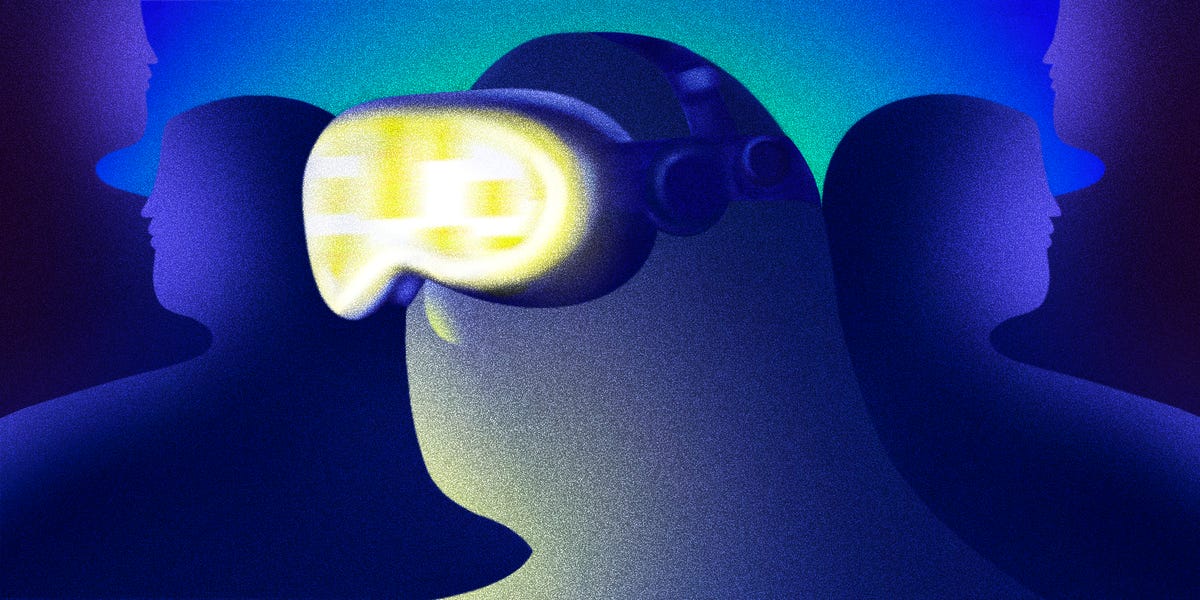I made a lot of questionable purchases as a teenage gadget geek in the 1990s, but the one that made my parents most regret giving me a credit card was the Sony Glasstron. The flimsy head-mounted display (which offered the “stunning” clarity of 800 x 600 pixels), the attached earbuds, and the video cable tether were all mine for the low, low price of $2,599 in 1999 dollars — or nearly $5K today. When the device arrived, delight turned to disappointment, and it was quickly returned. But my obsession with portable displays never went away. To me, it felt inevitable that we were on an evolutionary path toward perfect human-machine interfaces, erasing the separation between the infinite creativity of digital spaces and the limitations of our physical world.
So when the Apple Vision Pro arrived, I was giddy with excitement to dive into the type of toy I’d dreamt of since childhood. The long-delayed promise of augmented reality was finally here. But almost as soon as I strapped on these cyborg ski goggles, I wanted to throw them against the wall. Not only was I frustrated, I was terrified. Apple’s nearly $4,000 gimmick may be a bit of a flop for the company. But for the rest of us, it’s an extremely alarming harbinger of how tech giants are going to know even more about our private lives and radically reshape our communities once again.
The Vision Pro tries to answer the question of how you can use a computer without a mouse or keyboard. It answers it poorly. When you mount Apple’s personal panopticon to your face, an augmented-reality interface appears, using a dozen cameras to map out your environment. It films everything around you, every piece of furniture, every scrap of paper — Post-it notes, bank statements, health-insurance bills — even your choice of recreational beverage to show you a grainy, digitized copy of your world on a screen. It’s like seeing a funhouse version of your home, only with lots of apps layered on top.
My personal laptop doesn’t see the handwritten notes I leave loved ones or the passwords I type into other devices. My work computer’s webcam sees only the one highly stage-managed corner of my life I show it, the wall of books and awards carefully crafted with the hope my background could one day earn a score on Room Rater. Within seconds the Vision Pro had photographed more of my apartment and body than my laptop saw over the decade I’ve had it.
Just setting up the headset turned into a nauseating ordeal. Want to navigate an app? Use your hand to click and zoom. This felt amazing the first time I tried it, but clicking and zooming is no way to type. I can only imagine how it would have looked to someone in my living room, as I tried to hunt and peck letters on a simulated keyboard, constantly cursing in irritation. As I flailed at the imaginary keyboard, it became clear just how little thought Apple gave to one of the most important features of digital life: passwords.
Apple built this with only the die-hard Apple users in mind, especially those who have stored all of their data in Apple’s iCloud. For those of us who don’t exclusively use an iPhone, iPad, or MacBook, or who try to protect our privacy with tools outside the Appleverse, this product clearly wasn’t for us. That Appleverse lock-in effect, building products to work well with each other and badly with everyone else, isn’t a small oversight. In fact, this is at the core of a massive new antitrust lawsuit filed last week by the Department of Justice and 16 states, alleging that Apple weaponizes interoperability to maintain its iPhone monopoly. As a privacy professional, I practice what I preach on password security. After the fifth time I tried to peck out the randomized 20-character combination I used for Disney+, I was so filled with sickness and rage I needed a break. As a friend who tried my headset remarked, “It gave me the nausea of a roller coaster without any of the thrill.”
What a major fall from grace for the Cupertino colossus.
Apple built its brand on sleek seamlessness, making complex tech that normally scares off most users into beautiful, easy-to-use products. The iPod wasn’t the first MP3 player by a long shot, but Jony Ive’s smooth design is what made MP3 players as a category leap from niche product to ubiquity of modern life.
Apple’s white EarPods, and later its wireless AirPods, quickly leapt from subtle status symbol to de rigueur way to walk outside and ride public transit. Every city today is full of people listening to siloed content, using technology to live parallel, nonintersecting lives, even in crowded spaces. This may seem pedestrian today, but it’s nothing short of a remaking of the city soundscape and public spaces.
By the fifth time I tried to peck out my randomized 20-character combination for Disney+, I was filled with sickness and rage.
In 1990s New York, I grew up in a city that shared the same sounds. We overheard conversations and audibly interacted with the strangers around us, and even when we did have music — usually a boombox blasting by — it never fully muffled out the world around us.
This is what makes augmented reality like the Vision Pro so powerful, and so scary. It and its many successors to come are poised to do to our visual world what noise-canceling headphones and MP3 players did to our auditory realm. Soon, whether sitting in the park, on a plane, or in a waiting room, more and more of the people around you won’t see you, won’t be aware of you. They’ll be steeped in a visual playground only they can see. Apple Vision Pro marks the foundation of a new architecture of total digital isolation.
I felt that isolation even before I bought the device. Watching a dazzling demo while wearing a display set in the middle of the Apple Store, I was shepherded through photos and 3D movies that suddenly spooled out around me in an effect that was truly transporting. Perhaps the most thrilling part was the moment I adjusted the simulated environment around me. In one movement, the crowded store faded, and a white sand dune came into view, the noise around me faded as I could hear the mock wind. It felt like the first time I had turned on noise-canceling headphones, that magical feeling of an invisible shell cloaking me from the outside world. But the first red flag came a few minutes later when the serenity was interrupted by the voice of an Apple employee, asking a man nearby whether he knew me and the other people testing the Vision Pro, a man who had been filming all of us without our consent. A man I never saw. After a brief argument, their voices faded, but it was a jarring reminder that while I might not have been able to see the world around me, it could still see me, and blinding myself to reality came at a cost.
This isolation was supposed to be part of what set Vision Pro apart, turning the opaque barriers of traditional VR — which show a wholly simulated environment — into a translucent membrane that allowed us to sit in both places at once. Once I put on the headset at home, however, that image faded. That first night, I gave up any hope that this device was truly compatible with the real world around it.
I also quickly found Vision Pro’s greatest weakness: walking. With my first step I saw the simulated version of my apartment shutter and shake, accelerating the growing motion sickness I felt when seated. From typing, to the two-hour battery life, to motion blurring, and an array of other malfunctions, it became clear that Apple really hadn’t worked out so many of the basics we’d need to make this a serious device, not just a toy. But it’s a toy that cost billions to build, and which highlights the path Apple plans all of us to take in the years ahead.
This is the part that scares me most, the design philosophy of computing we see seeping into the next generation of devices. The earliest computers were open sandboxes of creativity, where users could tinker and tweak settings to their heart’s desire. But later generations of devices, especially smartphones and tablets, are increasingly walled gardens where we’re allowed to wander only within narrow, predetermined parameters. The Vision Pro could never replace a desktop or laptop, but it’s a looming successor for the iPad, a simulacrum of a computer giving users just enough power to think they’re in control, while more and more locking down the tools that wonks like me use to take ownership of our digital life.
We won’t look back on Vision Pro as Apple’s new iPhone moment. If anything, it’s the spiritual successor to the Newton, the widely mocked 1990s PDA.
For me, this means having to pay a hefty monthly iCloud fee just to access my files. In Apple’s vision of the future there is no local storage, no local control, only the company’s cloud. And I found countless features failed the moment I took the most rudimentary security precautions, such as using a VPN. Apple touted your ability to use the Apple Vision Pro to connect to your laptop, simulating a screen for your device. But no matter how much I tried, I never found a comfortable way to even write a Microsoft Word document or email while strapped in. When I connected my MacBook to use the display, the lagging cursor constantly threw me off, every disorienting keystroke delayed before it appeared on my simulated screen. Even when I bought a Bluetooth keyboard, I was still able to type out only a couple of short paragraphs before the eye strain became overpowering.
Vision Pro isn’t for creating content. It isn’t for interacting with the world. It isn’t even for walking around your own apartment. At best, at its core, it’s yet another way for us to zone out and watch ever higher and higher definition TV and movies. I’ve never in my adult life vegged out as much as I did during my time with the Vision Pro. The display made graphics-rich 3D movies better than they had ever looked in my home (where I don’t actually have a TV). But as soon as I tried character dramas and off-beat comedies, the virtual theater felt suffocating, and profoundly isolating. This technology is uniquely able to cut us off, even when we’re in a crowded space. I imagine a family gathered on the couch, each person watching their own show, completely siloed — it’s tragic. If I actually wanted more screens in my life, I’d spend the $4,000 on a cutting-edge projector my friends and I could watch together.
In the end, I followed the path of so many other Vision Pro early adopters and became an early returner. We won’t look back on Vision Pro as Apple’s new iPhone moment. If anything, it’s the spiritual successor to the Newton, the widely mocked 1990s PDA. But just like the Newton, this buggy beta test of a product launch also foreshadows technology trends just around the corner. And as future headsets blind us and isolate us, we may not be able to see the next corner.
Albert Fox Cahn is the founder and executive director of the Surveillance Technology Oversight Project, or STOP, a New York-based civil-rights and privacy group.




